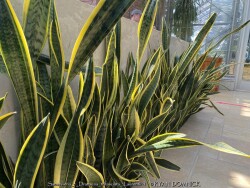

Green and yellow leaves from this Sansevieria (Sansevieria / Dracaena trifasciata 'Laurentii') make an excellent architectural statement. Most Sansevieria are native to are native to rocky, dry habitats in tropical Africa but used as a patio or house plant in Kansas. Grow in full sun to part sun with optional extra watering including that which comes from rainfall. Plants with plenty of time to acclimate will thrive in full sun but be careful not to rush it or sunburning will occur. Generally if moving outside for the summer, allow 2-3 weeks of part shade or morning sun before placing in full sun. Or just keep in part shade or under an overhang. Repotting may or may not be needed depending on how large you want the plant to grow; plants can continue to grow and tolerate extremely root-bound pots but may need wind bracing. Some species root systems will build up enough pressure and will simply break the pot as a friendly reminder when it's time to re-pot! Protect from temperatures below 45 degrees F and move into a bright window over the winter with no watering. Do not allow Sansevieria to freeze or even get close to freezing especially if soil is wet or death may occur. As a winter house plant, it will look presentable all winter long with just a few monthly or no waterings if you forget. As a permanent house plant, provide bright light and allow the soil to dry between waterings for many years of carefree enjoyment. Potted plants are very low maintenance needing only old leaves trimmed once per year. This is the basic big-box store sansevieria is often grown as a house plant.
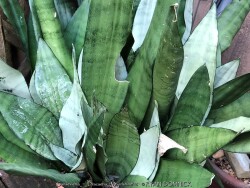

Dwarf whitish green leaves from this Moonshine Sansevieria (Sansevieria / Dracaena trifasciata 'Moonshine') make an excellent architectural statement. Most Sansevieria are native to are native to rocky, dry habitats in tropical Africa but used as a patio or house plant in Kansas. Grow in full sun to part sun with optional extra watering including that which comes from rainfall. Plants with plenty of time to acclimate will thrive in full sun but be careful not to rush it or sunburning will occur. Generally if moving outside for the summer, allow 2-3 weeks of part shade or morning sun before placing in full sun. Or just keep in part shade or under an overhang. Repotting may or may not be needed depending on how large you want the plant to grow; plants can continue to grow and tolerate extremely root-bound pots but may need wind bracing. Some species root systems will build up enough pressure and will simply break the pot as a friendly reminder when it's time to re-pot! Protect from temperatures below 45 degrees F and move into a bright window over the winter with no watering. Do not allow Sansevieria to freeze or even get close to freezing especially if soil is wet or death may occur. As a winter house plant, it will look presentable all winter long with just a few monthly or no waterings if you forget. As a permanent house plant, provide bright light and allow the soil to dry between waterings for many years of carefree enjoyment. Potted plants are very low maintenance needing only old leaves trimmed once per year. Moonshine Sansevieria is one of the more slow-growing and most sought-after snake plants often grown as a specimen house plant.
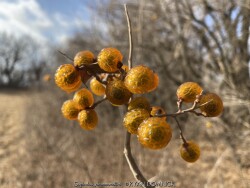

***Tree descriptions available with future update!***
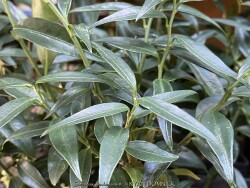

Himalayan Sweet Box (Sarcococca hookeriana) is planted for its evergreen dark green foliage and white flowers. Foliage maintains well all year provided that certain cultural conditions are met. Native to shaded mountain areas in forests, valleys or along streams in the Himalayas, it needs moist soil rich in organic matter avoiding too much clay. It is somewhat drought tolerant once established. If low temperatures hit -5 to -10 degrees F, foliage finally dies back to the ground and re-emerges in early spring. Generally this plant can decline after a few years of Kansas climate but is worth a try in perfect soils in well-tended shade gardens. If low temperatures hit -10 degrees F, it may kill an un-mulched plant; protect any zone 6 plant with thick layer of mulch. Lack of moisture and competition with weeds seem to be an issue but it survives just fine. Growth is extremely slow. This is one of the most deep shade tolerant plants available.
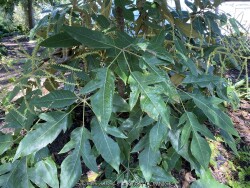

***Description for this plant available with future update!***
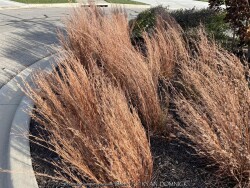

Little bluestem (Schizachyrium scoparium) is a prominent prairie grass usually found in the short to medium grass prairies of Kansas and most common in the midwest and Great Plains. It also occurs sporadically throughout most of the United States in open areas where trees cannot grow. The spring and summer foliage is mint green to blue green. Depending on the variety, they gradually turn a reddish purple color in late summer progressing to deeper reddish purple, red, or orange by fall. At this time when the seed heads have extended, it is at its prettiest. As cold weather sets in and freezes occur, dried foliage turns a pinkish orange with tan and red shades again depending on the variety. Winter color is persistent and lasts until spring cut back in March. Little bluestem is very tolerant of different soils but prefers dry, sandy, loam, or clay soils with plenty of full sun. If planted in rich soil or given too much water, plants tend to grow too tall and flop by late summer. However, there are now improved cultivars that resist flopping. Good air circulation and some wind is needed to avoid rust diseases in humid areas. Sometimes if planted too shallow or if mulched too thickly, plants can heave and die in the winter. In the landscape, little bluestem looks best when planted in medium to large groups giving the look of a miniature prairie. It also combines very well with many other plants that have different textures and colors. Generally if given the proper placement and growing conditions, little bluestem will last indefinitely. Little bluestem as one of the four major grasses (along with Big bluestem, Indiangrass, and Switchgrass) covering millions of acres and Kansas including the Flint Hills. Where and when conditions are safe, it can be burned in late winter or early spring in a prairie or meadow before new growth appears. Many cultivars have been released improving foliage color and flop resistance.
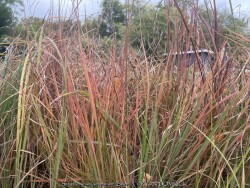

Little bluestem (Schizachyrium scoparium) is a prominent prairie grass usually found in the short to medium grass prairies of Kansas and most common in the midwest and Great Plains. It also occurs sporadically throughout most of the United States in open areas where trees cannot grow. The spring and summer foliage is mint green to blue green. Depending on the variety, they gradually turn a reddish purple color in late summer progressing to deeper reddish purple, red, or orange by fall. At this time when the seed heads have extended, it is at its prettiest. As cold weather sets in and freezes occur, dried foliage turns a pinkish orange with tan and red shades again depending on the variety. Winter color is persistent and lasts until spring cut back in March. Little bluestem is very tolerant of different soils but prefers dry, sandy, loam, or clay soils with plenty of full sun. If planted in rich soil or given too much water, plants tend to grow too tall and flop by late summer. However, there are now improved cultivars that resist flopping. Good air circulation and some wind is needed to avoid rust diseases in humid areas. Sometimes if planted too shallow or if mulched too thickly, plants can heave and die in the winter. In the landscape, little bluestem looks best when planted in medium to large groups giving the look of a miniature prairie. It also combines very well with many other plants that have different textures and colors. Generally if given the proper placement and growing conditions, little bluestem will last indefinitely. Little bluestem as one of the four major grasses (along with Big bluestem, Indiangrass, and Switchgrass) covering millions of acres and Kansas including the Flint Hills. Where and when conditions are safe, it can be burned in late winter or early spring in a prairie or meadow before new growth appears. Many cultivars have been released improving foliage color and flop resistance. Blaze Little Bluestem Grass (Schizachyrium scoparium 'Blaze') is a cultivar originally selected by agronomists in Nebraska as a high yielding pasture grass. Blaze is also used ornamentally for its vivid red fall foliage. In winter it remains a standout as the leaves fade to deep pink and is considered one of the best for winter color.


Little bluestem (Schizachyrium scoparium) is a prominent prairie grass usually found in the short to medium grass prairies of Kansas and most common in the midwest and Great Plains. It also occurs sporadically throughout most of the United States in open areas where trees cannot grow. The spring and summer foliage is mint green to blue green. Depending on the variety, they gradually turn a reddish purple color in late summer progressing to deeper reddish purple, red, or orange by fall. At this time when the seed heads have extended, it is at its prettiest. As cold weather sets in and freezes occur, dried foliage turns a pinkish orange with tan and red shades again depending on the variety. Winter color is persistent and lasts until spring cut back in March. Little bluestem is very tolerant of different soils but prefers dry, sandy, loam, or clay soils with plenty of full sun. If planted in rich soil or given too much water, plants tend to grow too tall and flop by late summer. However, there are now improved cultivars that resist flopping. Good air circulation and some wind is needed to avoid rust diseases in humid areas. Sometimes if planted too shallow or if mulched too thickly, plants can heave and die in the winter. In the landscape, little bluestem looks best when planted in medium to large groups giving the look of a miniature prairie. It also combines very well with many other plants that have different textures and colors. Generally if given the proper placement and growing conditions, little bluestem will last indefinitely. Little bluestem as one of the four major grasses (along with Big bluestem, Indiangrass, and Switchgrass) covering millions of acres and Kansas including the Flint Hills. Where and when conditions are safe, it can be burned in late winter or early spring in a prairie or meadow before new growth appears. Many cultivars have been released improving foliage color and flop resistance. Standing Ovation Little Bluestem Grass (Schizachyrium scoparium 'Standing Ovation') is characterized by its wide leaf blades and its blue foliage with red tips throughout the growing season that change to red and maroon in fall with rich purple coloring at the base. It is upright and has a rigid habit that is retained without lodging when plants are grown in rich soils or during container production. Standing Ovation is a North Creek Nurseries Inc. introduction from Pennsylvania.
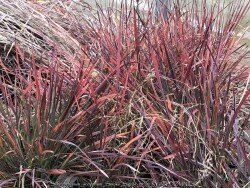

Little bluestem (Schizachyrium scoparium) is a prominent prairie grass usually found in the short to medium grass prairies of Kansas and most common in the midwest and Great Plains. It also occurs sporadically throughout most of the United States in open areas where trees cannot grow. The spring and summer foliage is mint green to blue green. Depending on the variety, they gradually turn a reddish purple color in late summer progressing to deeper reddish purple, red, or orange by fall. At this time when the seed heads have extended, it is at its prettiest. As cold weather sets in and freezes occur, dried foliage turns a pinkish orange with tan and red shades again depending on the variety. Winter color is persistent and lasts until spring cut back in March. Little bluestem is very tolerant of different soils but prefers dry, sandy, loam, or clay soils with plenty of full sun. If planted in rich soil or given too much water, plants tend to grow too tall and flop by late summer. However, there are now improved cultivars that resist flopping. Good air circulation and some wind is needed to avoid rust diseases in humid areas. Sometimes if planted too shallow or if mulched too thickly, plants can heave and die in the winter. In the landscape, little bluestem looks best when planted in medium to large groups giving the look of a miniature prairie. It also combines very well with many other plants that have different textures and colors. Generally if given the proper placement and growing conditions, little bluestem will last indefinitely. Little bluestem as one of the four major grasses (along with Big bluestem, Indiangrass, and Switchgrass) covering millions of acres and Kansas including the Flint Hills. Where and when conditions are safe, it can be burned in late winter or early spring in a prairie or meadow before new growth appears. Many cultivars have been released improving foliage color and flop resistance. Smoke Signal Little Bluestem Grass (Schizachyrium scoparium 'Smoke Signal') has a beautifully refined habit and puts forth a strong show of color in late summer and fall. The glaucous blue-green foliage begins to take on scarlet red tones in late summer, turning a deeper red-purple through the fall. Tiny, tan seed heads appear in early fall on the top half of the stems. An improvement over older cultivars, this grass maintains its strictly upright habit through fall. Smoke Signal is a Walters Gardens Inc. introduction.
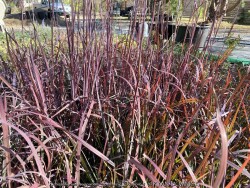

Little bluestem (Schizachyrium scoparium) is a prominent prairie grass usually found in the short to medium grass prairies of Kansas and most common in the midwest and Great Plains. It also occurs sporadically throughout most of the United States in open areas where trees cannot grow. The spring and summer foliage is mint green to blue green. Depending on the variety, they gradually turn a reddish purple color in late summer progressing to deeper reddish purple, red, or orange by fall. At this time when the seed heads have extended, it is at its prettiest. As cold weather sets in and freezes occur, dried foliage turns a pinkish orange with tan and red shades again depending on the variety. Winter color is persistent and lasts until spring cut back in March. Little bluestem is very tolerant of different soils but prefers dry, sandy, loam, or clay soils with plenty of full sun. If planted in rich soil or given too much water, plants tend to grow too tall and flop by late summer. However, there are now improved cultivars that resist flopping. Good air circulation and some wind is needed to avoid rust diseases in humid areas. Sometimes if planted too shallow or if mulched too thickly, plants can heave and die in the winter. In the landscape, little bluestem looks best when planted in medium to large groups giving the look of a miniature prairie. It also combines very well with many other plants that have different textures and colors. Generally if given the proper placement and growing conditions, little bluestem will last indefinitely. Little bluestem as one of the four major grasses (along with Big bluestem, Indiangrass, and Switchgrass) covering millions of acres and Kansas including the Flint Hills. Where and when conditions are safe, it can be burned in late winter or early spring in a prairie or meadow before new growth appears. Many cultivars have been released improving foliage color and flop resistance. Standing Ovation Little Bluestem Grass (Schizachyrium scoparium 'Standing Ovation') is characterized by its wide leaf blades and its blue foliage with red tips throughout the growing season that change to red and maroon in fall with rich purple coloring at the base. It is upright and has a rigid habit that is retained without lodging when plants are grown in rich soils or during container production. Standing Ovation is a North Creek Nurseries Inc. introduction from Pennsylvania.


***Description for this perennial available with future update!***
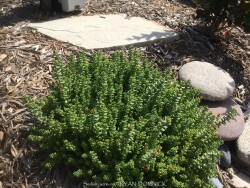

***Description for this perennial available with future update!***Mossy Stonecrop / Sedum, is also known as Sedum acre
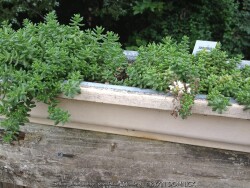

***Description for this perennial available with future update!***White Creeping Sedum, is also known as Sedum album
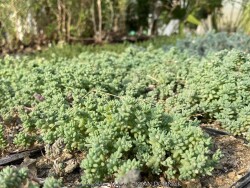

***Description for this perennial available with future update!***Blue Corsican Sedum, is also known as Sedum dasyphyllum 'Major'
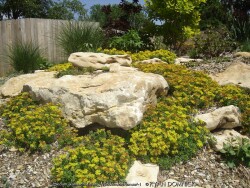

Kamtschaticum Sedum (Sedum kamtschaticum) is known for its compact mats of bright green foliage and yellow-gold flowers in the spring. Fall color turns a beautiful firey orange-red before going dormant. Kamtschaticum Sedum is native to northern China and along the Pacific coast of Siberia including the Kamchatka Peninsula with a similar climate of cold winters and hot summers. Bright green growth emerges early in the spring and spread slowly, rooting a little bit as it spreads but not aggressively. Growth is dense enough to resist most weeds. Kamtschaticum Sedum is useful as a small scale groundcover, rock garden plant, retaining wall plant, or even dry shade gardens. This tough sedum will grow in full sun to full shade in just about any soil except for wet poorly drained ones. Of all of the sedums, this is probably the most resistant to any kind of problems including root rot. I have witnessed clumps surviving and thriving for 20-30 years or more. There is really almost no maintenance with this sedum but you may choose to weed eat it in the winter for a more tidy appearance. The only slight problem is that when grown with too much water, The crown opens up as it flops over and looks slightly untidy. The flowering period is also pretty short. Considered one of the best plants for solving your most difficult dry-shade landscape challenges. Tooth-Leaf Kamtschaticum Sedum (Sedum kamtschaticum var. middendorffianum) is a shorter more drought tolerant variety with tooth-like jagged edges. The clump does not open up and flop. This variety is also more tolerant of full hot sun and shallow soils also making it an ideal roof-garden plant.
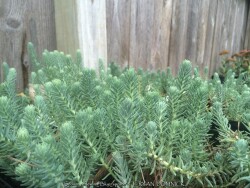

***Description for this perennial available with future update!***Blue Spruce Sedum, is also known as Sedum reflexum
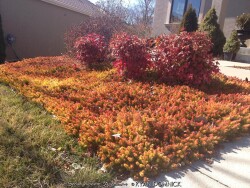

***Description for this perennial available with future update!***Angelina Gold & Orange Sedum, is also known as Sedum rupestre 'Angelina'
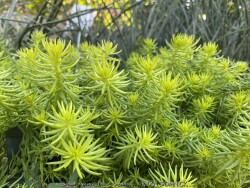

***Description for this perennial available with future update!*** NEEDS EDIT>>>>>> Sedum Prima Angelina has a denser, more compact habit and more vivid golden color than Angelina. According to Plant Delights nursery, "Sedum rupestre 'Prima Angelina' is a superb new improvement of the wildly popular, Sedum 'Angelina'. This compact, better-branched, brighter colored sport was discovered by Ohio's Jared Hughes. Sedum 'Prima Angelina' has thrived in our hot, humid summers. We particularly like that this new gem remains bright gold in cold weather, where its' parent takes on an orange cast in winter. So far, no flowers have been observed on the sport."
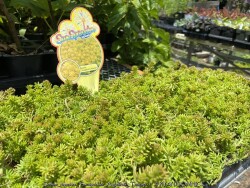

***Description for this perennial available with future update!***Sunsparkler Angelina's Teacup Gold & Orange Sedum, is also known as Sedum rupestre 'Sunsparkler Angelina's Teacup'
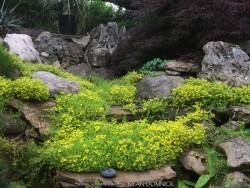

***Description for this perennial available with future update!***>>>>>This plant can also be in a water garden stream as long as the water is constantly moving: stagnant water is not tolerated. Considered one of the best plants for solving your most difficult dry-shade landscape challenges.
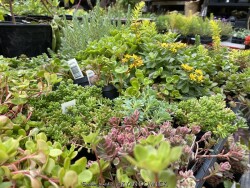

***Description for this perennial available with future update!***Sedum (Mixed Groundcover flats), is also known as Sedum sp.
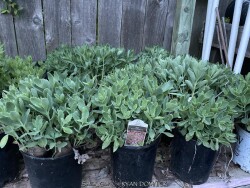

***Description for this perennial available with future update!***Sedum (Mixed Varieties) (large), is also known as Sedum sp.
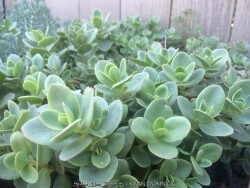

***Description for this perennial available with future update!***Sedum (Mixed Varieties) (small), is also known as Sedum sp.
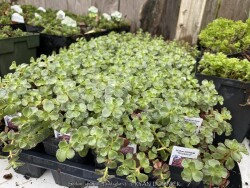

***Description for this perennial available with future update!***Improved Dragon's Blood Sedum, is also known as Sedum spurium 'Fuldaglut' / 'Fulda Glow'
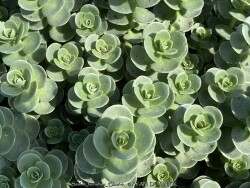

***Description for this perennial available with future update!***Native White Sedum, is also known as Sedum ternatum
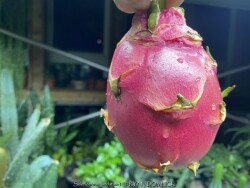

Dragon Fruit cacti are grown for delicious nutritious fruits. This tropical jungle cactus has a few requirements in order to thrive but nothing too hard. Give them bright indirect light and water only when dry. They are usually grown as a house plant in Kansas but can be moved outside if kept in part shade to shade. Leaves can sunburn but morning or filtered sun is ok! Dragon Fruit, like all true cacti, originates in the Americas. It is a sprawling or vining, terrestrial or epiphytic cactus. They climb trees and walls by use of aerial roots and can reach a height of 30 feet in the wild. Protect from temperatures below 45 degrees F and move into a bright window over the winter with no watering. As a winter house plant, it will look presentable all winter long with just a few waterings. Repotting may or may not be needed depending on how large you want the plant to grow; plants can continue to grow in the same pot for years. If repotting, make sure to use a sharp draining highly organic cactus mix with plenty of sand and perlite. This is relatively uncommon plant never seen at the big box stores and will command a higher price than most other houseplants. Plants are usually grown in hanging baskets and take up alot of space. Fruit may or may not occur in this climate; I have seen flowering but not fruit.
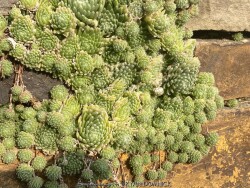

These tiny perennial succulents (Sempervivum sp.) produce various colored mats of foliage rosettes. In favorable conditions they can spread rapidly by offsets; several species are valued in cultivation as groundcover for dry, sunny locations. Hen & Chicks are native to alpine mountainous areas in native to southern Europe and northern Africa. Grow this small native gem in a rock garden, in cracks between rocks, or on top of or in a retaining wall. You may also grow in flat areas like in between stepping stones provided you used a gravelly or sandy base for the stones. It will not tolerate rich moist soils as other plants or weeds will shade it out. Crown rot can occur during lengthy hot humid summer rainy periods. Hen & Chicks do not thrive indoors; aphids and spider mites seem to find them after a few months but overwintering indoors in a cool environment may work. Plants with plenty of time to acclimate will thrive in full sun but be careful not to rush it or sunburning will occur. Generally if moving outside for the summer, allow 2-3 weeks of part shade or morning sun before placing in full sun. If grown in pots and kept on the dry side, you may leave out all winter allowing to freeze solid; plants will go dormant and resume growth in the spring. This is more successful than overwintering inside. Great low maintenance cold hardy succulent. Cobweb Hen & Chicks (Sempervivum arachnoideum) grow tiny and have tiny white hairs resembling cobwebs!
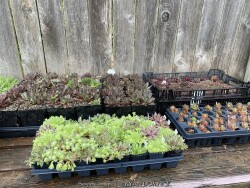

These tiny perennial succulents (Sempervivum sp.) produce various colored mats of foliage rosettes. In favorable conditions they can spread rapidly by offsets; several species are valued in cultivation as groundcover for dry, sunny locations. Hen & Chicks are native to alpine mountainous areas in native to southern Europe and northern Africa. Grow this small native gem in a rock garden, in cracks between rocks, or on top of or in a retaining wall. You may also grow in flat areas like in between stepping stones provided you used a gravelly or sandy base for the stones. It will not tolerate rich moist soils as other plants or weeds will shade it out. Crown rot can occur during lengthy hot humid summer rainy periods. Hen & Chicks do not thrive indoors; aphids and spider mites seem to find them after a few months but overwintering indoors in a cool environment may work. Plants with plenty of time to acclimate will thrive in full sun but be careful not to rush it or sunburning will occur. Generally if moving outside for the summer, allow 2-3 weeks of part shade or morning sun before placing in full sun. If grown in pots and kept on the dry side, you may leave out all winter allowing to freeze solid; plants will go dormant and resume growth in the spring. This is more successful than overwintering inside. Great low maintenance cold hardy succulent.
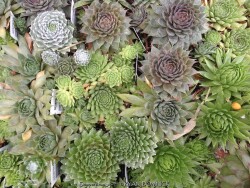

These tiny perennial succulents (Sempervivum sp.) produce various colored mats of foliage rosettes. In favorable conditions they can spread rapidly by offsets; several species are valued in cultivation as groundcover for dry, sunny locations. Hen & Chicks are native to alpine mountainous areas in native to southern Europe and northern Africa. Grow this small native gem in a rock garden, in cracks between rocks, or on top of or in a retaining wall. You may also grow in flat areas like in between stepping stones provided you used a gravelly or sandy base for the stones. It will not tolerate rich moist soils as other plants or weeds will shade it out. Crown rot can occur during lengthy hot humid summer rainy periods. Hen & Chicks do not thrive indoors; aphids and spider mites seem to find them after a few months but overwintering indoors in a cool environment may work. Plants with plenty of time to acclimate will thrive in full sun but be careful not to rush it or sunburning will occur. Generally if moving outside for the summer, allow 2-3 weeks of part shade or morning sun before placing in full sun. If grown in pots and kept on the dry side, you may leave out all winter allowing to freeze solid; plants will go dormant and resume growth in the spring. This is more successful than overwintering inside. Great low maintenance cold hardy succulent.
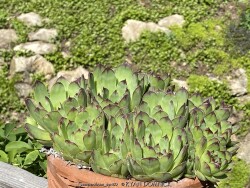

These tiny perennial succulents (Sempervivum sp.) produce various colored mats of foliage rosettes. In favorable conditions they can spread rapidly by offsets; several species are valued in cultivation as groundcover for dry, sunny locations. Hen & Chicks are native to alpine mountainous areas in native to southern Europe and northern Africa. Grow this small native gem in a rock garden, in cracks between rocks, or on top of or in a retaining wall. You may also grow in flat areas like in between stepping stones provided you used a gravelly or sandy base for the stones. It will not tolerate rich moist soils as other plants or weeds will shade it out. Crown rot can occur during lengthy hot humid summer rainy periods. Hen & Chicks do not thrive indoors; aphids and spider mites seem to find them after a few months but overwintering indoors in a cool environment may work. Plants with plenty of time to acclimate will thrive in full sun but be careful not to rush it or sunburning will occur. Generally if moving outside for the summer, allow 2-3 weeks of part shade or morning sun before placing in full sun. If grown in pots and kept on the dry side, you may leave out all winter allowing to freeze solid; plants will go dormant and resume growth in the spring. This is more successful than overwintering inside. Great low maintenance cold hardy succulent. Red-tip Green Hen & Chicks are among the largest, most reliable, and fastest growing.
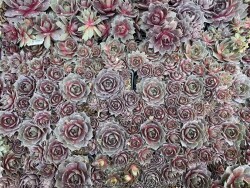

These tiny perennial succulents (Sempervivum sp.) produce various colored mats of foliage rosettes. In favorable conditions they can spread rapidly by offsets; several species are valued in cultivation as groundcover for dry, sunny locations. Hen & Chicks are native to alpine mountainous areas in native to southern Europe and northern Africa. Grow this small native gem in a rock garden, in cracks between rocks, or on top of or in a retaining wall. You may also grow in flat areas like in between stepping stones provided you used a gravelly or sandy base for the stones. It will not tolerate rich moist soils as other plants or weeds will shade it out. Crown rot can occur during lengthy hot humid summer rainy periods. Hen & Chicks do not thrive indoors; aphids and spider mites seem to find them after a few months but overwintering indoors in a cool environment may work. Plants with plenty of time to acclimate will thrive in full sun but be careful not to rush it or sunburning will occur. Generally if moving outside for the summer, allow 2-3 weeks of part shade or morning sun before placing in full sun. If grown in pots and kept on the dry side, you may leave out all winter allowing to freeze solid; plants will go dormant and resume growth in the spring. This is more successful than overwintering inside. Great low maintenance cold hardy succulent. Burgundy Hen & Chicks (Sempervivum tectorum) are brightly colored with new growth emerging bright purple darkening with age.
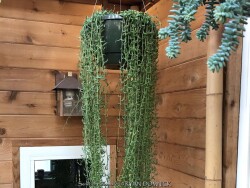

String of Bananas (Senecio / Curio radicans) grows long green stems with interesting banana-shaped alternating leaves. They are usually grown as a patio or house plant in Kansas. String of Bananas also grow well in hanging baskets as a durable, succulent plant able to survive drying out, heat and dry air like few others! To play is safe, potted plants are best moved in before night temperatures get below 45 degrees F. It is important to avoid the combination of wet and cold. Before extreme cold occurs, move to a bright interior window over the winter with no watering and keep above freezing. As a winter house plant, it will look presentable all winter long with just no waterings. As a permanent house plant, provide bright light and allow the soil to dry between waterings for many years of carefree enjoyment. Generally if moving outside for the summer, allow 1-2 weeks of part shade or morning sun before placing in full sun. Plants with time to acclimate will thrive in full sun but be careful not to rush it or sunburning will occur. Full hot sun over 100 degrees F can also burn the top of the hanging basket killing the stems where they touch the pot rim and dirt. Avoid this by moving into part-shade during the hottest part of the summer. Potted plants are very low maintenance. I have never seen any insect problems on this plant. String of Bananas is the toughest, most trouble-free of the Senecio cascaders.
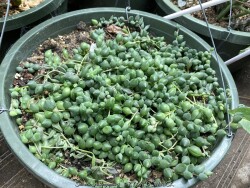

String of Pearls (Senecio / Curio rowleyanus) grows long green stems with interesting sphere-shaped alternating leaves. They are usually grown as a patio or house plant in Kansas. String of Pearls also grow well in hanging baskets as a durable, succulent plant able to survive drying out, heat and dry air like few others! To play is safe, potted plants are best moved in before night temperatures get below 45 degrees F. It is important to avoid the combination of wet and cold. Before extreme cold occurs, move to a bright interior window over the winter with no watering and keep above freezing. As a winter house plant, it will look presentable all winter long with just no waterings. As a permanent house plant, provide bright light and allow the soil to dry between waterings for many years of carefree enjoyment. Generally if moving outside for the summer, allow 1-2 weeks of part shade or morning sun before placing in full sun. Plants with time to acclimate will thrive in full sun but be careful not to rush it or sunburning will occur. Full hot sun over 100 degrees F can also burn the top of the hanging basket killing the stems where they touch the pot rim and dirt. Avoid this by moving into part-shade during the hottest part of the summer. Potted plants are very low maintenance. I have never seen any insect problems on this plant.
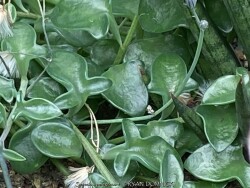

String of Dolphins (Senecio / Curio x peregrinum) grows long green stems with interesting dolphin-shaped alternating leaves. They are usually grown as a patio or house plant in Kansas. String of Dolphins also grow well in hanging baskets as a durable, succulent plant able to survive drying out, heat and dry air like few others! To play is safe, potted plants are best moved in before night temperatures get below 45 degrees F. It is important to avoid the combination of wet and cold. Before extreme cold occurs, move to a bright interior window over the winter with no watering and keep above freezing. As a winter house plant, it will look presentable all winter long with just no waterings. As a permanent house plant, provide bright light and allow the soil to dry between waterings for many years of carefree enjoyment. Generally if moving outside for the summer, allow 1-2 weeks of part shade or morning sun before placing in full sun. Plants with time to acclimate will thrive in full sun but be careful not to rush it or sunburning will occur. Full hot sun over 100 degrees F can also burn the top of the hanging basket killing the stems where they touch the pot rim and dirt. Avoid this by moving into part-shade during the hottest part of the summer. Potted plants are very low maintenance. I have never seen any insect problems on this plant.
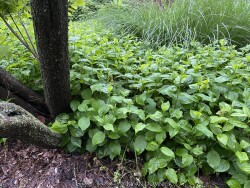

Zig Zag Goldenrod (Solidago flexicaulis) is native to the eastern and central parts of the United States and Canada. This woodland goldenrod, with erect, somewhat zig-zag stems, bears small flower heads at each node along the stem and upper leaves. The oval leaves are a rich green, pointed, and coarsely toothed. Considered one of the best plants for solving your most difficult dry-shade landscape challenges and still providing flowers. Goldenrods are not wind-pollinated and therefore do not cause standard hay fever or allergies. This goldenrod attracts butterflies. Rabbit and deer resistance is good. Zig Zag Goldenrod has been planted in our trial gardens over 10 years ago on a hill in part-sun to dry shade. The slowly expanding clump is virtually maintenance free, only needing trimmed in fate fall. Zig Zag Goldenrod is not well known or available in garden centers but worthy of wider scale landscape use.
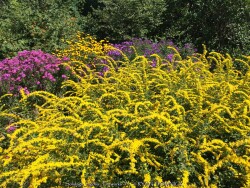

Fireworks Goldenrod (Solidago rugosa 'Fireworks') is the most garden-worthy of the goldenrods! It features dark green upright foliage. As the flower panicle matures, the expanding buds create a fine-textures cloud-like effect for about a month before the flowers open. When the flowers finally open in September, the radiating form really looks like fireworks! After flowering, the dried flower structure holds up well into fall offering winter interest until the first wet heavy snow. The species, Solidago rugosa, is native to the eastern and central parts of the United States and Canada. It is a highly adaptable goldenrod occuring in open moist areas such as low woods, meadows, old fields, pine barrens, and bogs. It is more tolerant of wet soils that other goldenrod. It prefers locations in full sun in average to moist soils that are well-drained but is adaptable to part shade or dappled shade. In Eastern Kansas, typically our 40 inches of rainfall is sufficient without extra water if planted in good soils. During the drought years in Eastern Kansas of 2011 and 2012, many Fireworks Goldenrods planted in landscapes that were not watered survived but dried up as flowers were trying to form. Goldenrods are not wind-pollinated and therefore do not cause standard hay fever or allergies. This goldenrod attracts wide variety of insects, including small bees, wasps, flies, small butterflies. Rabbit and deer resistance is good. The slowly expanding clump is virtually maintenance free, only needing trimmed in fate fall. Fireworks Goldenrod is generally very pest and disease resistant and can spread by creeping rhizomes or seed. Fireworks Goldenrod has been planted in our trial gardens over 18 years in mostly full sun with average garden soil. This is among our favorite perennials with truely 4 seasons of interest!
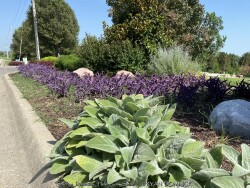

***Description for this perennial available with future update!***Helen Von Stein Lambs Ear, is also known as Stachys byzantina 'Helen Von Stein'
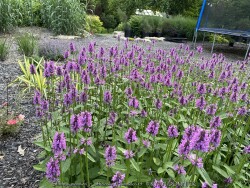

***Description for this perennial available with future update!***Hummelo Stachys (small), is also known as Stachys monieri / officinalis 'Hummelo'
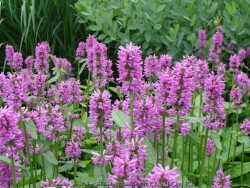

***Description for this perennial available with future update!***Hummelo Stachys (flat), is also known as Stachys monieri / officinalis 'Hummelo'
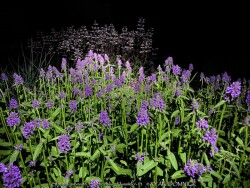

***Description for this perennial available with future update!***Hummelo Stachys (large), is also known as Stachys monieri / officinalis 'Hummelo'
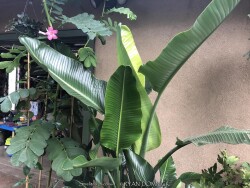

***Description for this plant available with future update!***White Bird of Paradise (Tropical), is also known as Strelitzia nicolai
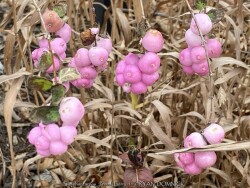

Coralberry (Symphoricarpos orbiculatus) is a spreading dwarf shrub native to much of the central and eastern United States including Kansas. It features mint green leaves that remain attractive all summer. Light pink flowers are barely noticeable but attractive upon close inspection. Ornamental clusters of magenta berries in the fall are the main attraction! The berries are very freeze-hardy clinging onto the leafless stems throughout most of the winter regardless of the minimum temperatures. This creates quite a show providing excellent color and interest to the winter landscape. While edible for some birds including robins, they seem to avoid the fruits unless it's a last resort. Coralberry is commonly grown as a spreading groundcover shrub for difficult areas. It will grow in full sun or full shade in medium to dry soils including dry-shade. It tolerates moist soil and floods for short periods of time. Fall leaf color is non-existent but ok because of the berry display. A brief window of time exists in the fall where the plant has beautiful green foliage and contrasting magenta berries at the same time. In the landscape, it is commonly used as large mass planting on hills. Because of its tolerance for adverse conditions including poor soil and rock, it is often one of the last resort plants that will survive in certain areas. It competes well under large shade trees and helps absorb leaf litter allowing it to break down and add nutrients back to the soil. This plant also does well in full sun; berry density is much greater in full sun. Plants can also be planted on the north side of a house, being extremely cold hardy with no winterkill. Another great spot is planting on top of a retaining wall allowing it to cascade down. We do not recommend planting in small areas or in spaces that it will overrun neighboring plants. It only spreads above ground as horizontally growing stems touch the ground and root. This does make maintenance easier to control the spread of the plant versus digging out rhizomes. Considered one of the best plants for solving your most difficult dry-shade landscape challenges. Proud Berry Pink Coralberry (Symphoricarpos 'Proud Berry') is a Proven Winners® selection that has much larger pink berries in large clusters. Fruit lasts into December but is quicker to dessicate than the true native magenta coralberry. All Proven Winners® plants are legally propagated, healthy and vigorous, true to name, and tagged with color pictures and growing information.


Magical Treasure Snowberry / Coralberry (Symphoricarpos doornsbosii ‘Magical Treasure’) is a spreading dwarf shrub native to much of the northern and central United States. It features mint green leaves that remain attractive all summer. Light pink flowers are barely noticeable but attractive upon close inspection. Ornamental clusters of magenta berries in the fall are the main attraction! The berries are very freeze-hardy clinging onto the leafless stems throughout most of the winter regardless of the minimum temperatures. This creates quite a show providing excellent color and interest to the winter landscape. While edible for some birds including robins, they seem to avoid the fruits unless it's a last resort. Coralberry is commonly grown as a spreading groundcover shrub for difficult areas. It will grow in full sun or full shade in medium to dry soils including dry-shade. It tolerates moist soil and floods for short periods of time. Fall leaf color is non-existent but ok because of the berry display. A brief window of time exists in the fall where the plant has beautiful green foliage and contrasting magenta berries at the same time. In the landscape, it is commonly used as large mass planting on hills. Because of its tolerance for adverse conditions including poor soil and rock, it is often one of the last resort plants that will survive in certain areas. It competes well under large shade trees and helps absorb leaf litter allowing it to break down and add nutrients back to the soil. This plant also does well in full sun; berry density is much greater in full sun. Plants can also be planted on the north side of a house, being extremely cold hardy with no winterkill. Another great spot is planting on top of a retaining wall allowing it to cascade down. We do not recommend planting in small areas or in spaces that it will overrun neighboring plants. It only spreads above ground as horizontally growing stems touch the ground and root. This does make maintenance easier to control the spread of the plant versus digging out rhizomes. Considered one of the best plants for solving your most difficult dry-shade landscape challenges. Magical Treasure Snowberry / Coralberry in a dwarf variety maxing out at 18-24" tall. Berries are larger and more colorful than the species, providing a great source of autumn cut stems for fall arrangements. Full sun will increase ornamental autumn fruit production without as much foliage furn.
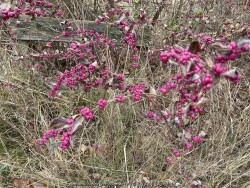

Coralberry (Symphoricarpos orbiculatus) is a spreading dwarf shrub native to much of the central and eastern United States including Kansas. It features mint green leaves that remain attractive all summer. Light pink flowers are barely noticeable but attractive upon close inspection. Ornamental clusters of magenta berries in the fall are the main attraction! The berries are very freeze-hardy clinging onto the leafless stems throughout most of the winter regardless of the minimum temperatures. This creates quite a show providing excellent color and interest to the winter landscape. While edible for some birds including robins, they seem to avoid the fruits unless it's a last resort. Coralberry is commonly grown as a spreading groundcover shrub for difficult areas. It will grow in full sun or full shade in medium to dry soils including dry-shade. It tolerates moist soil and floods for short periods of time. Fall leaf color is non-existent but ok because of the berry display. A brief window of time exists in the fall where the plant has beautiful green foliage and contrasting magenta berries at the same time. In the landscape, it is commonly used as large mass planting on hills. Because of its tolerance for adverse conditions including poor soil and rock, it is often one of the last resort plants that will survive in certain areas. It competes well under large shade trees and helps absorb leaf litter allowing it to break down and add nutrients back to the soil. This plant also does well in full sun; berry density is much greater in full sun. Plants can also be planted on the north side of a house, being extremely cold hardy with no winterkill. Another great spot is planting on top of a retaining wall allowing it to cascade down. We do not recommend planting in small areas or in spaces that it will overrun neighboring plants. It only spreads above ground as horizontally growing stems touch the ground and root. This does make maintenance easier to control the spread of the plant versus digging out rhizomes. Considered one of the best plants for solving your most difficult dry-shade landscape challenges.
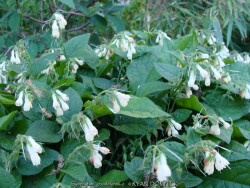

Dry Shade Comfrey / Large-Flowered Comfrey (Symphytum grandiflorum) is a perennial native to Europe with textured sandpapery green leaves and light yellow flowers. It spreads by creeping rhizomes and forms an attractive groundcover. Foliage is quite dense forming a tight weed resistant covering. Comfrey prefers rich average to moist well-drained soils with part sun to full shade. However, being a tolerant plant, is very adaptable to both dry and moist locations and will grow quite nicely in dry shade. It is not particular as to soil type or pH. and is highly tolerant of urban pollution and will even thrive in inner city environments. There is virtually no maintenance unless you want to mow down the dead foliage in the winter. It is also suggested to deadhead the flowers after blooming as they are not attractive. But if you don't, they will die back on their own and get swallowed up by the foliage. In addition to being a great perennial for your landscape, this comfrey may have herbal uses as well. There are no pest, disease, or browser problems. Considered one of the best plants for solving your most difficult dry-shade landscape challenges. The blue variety, Symphytum grandiflorum 'Hidcote Blue', has more of a blue green foliage and light blue flowers on taller flower spikes. Spread is also more rapid and sometimes to the point of aggressive and rich moist soil. Comfrey is a great underused plant worthy of more wide scale use in the landscape. Dry Shade Comfrey has persisted through over a decade in our Lawrence, KS display garden with no problems.
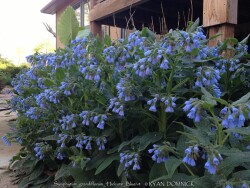

Dry Shade Comfrey / Large-Flowered Comfrey (Symphytum grandiflorum) is a perennial native to Europe with textured sandpapery green leaves and light yellow flowers. It spreads by creeping rhizomes and forms an attractive groundcover. Foliage is quite dense forming a tight weed resistant covering. Comfrey prefers rich average to moist well-drained soils with part sun to full shade. However, being a tolerant plant, is very adaptable to both dry and moist locations and will grow quite nicely in dry shade. It is not particular as to soil type or pH. and is highly tolerant of urban pollution and will even thrive in inner city environments. There is virtually no maintenance unless you want to mow down the dead foliage in the winter. It is also suggested to deadhead the flowers after blooming as they are not attractive. But if you don't, they will die back on their own and get swallowed up by the foliage. In addition to being a great perennial for your landscape, this comfrey may have herbal uses as well. There are no pest, disease, or browser problems. Considered one of the best plants for solving your most difficult dry-shade landscape challenges. The blue variety, Symphytum grandiflorum 'Hidcote Blue', has more of a blue green foliage and light blue flowers on taller flower spikes. Spread is also more rapid and sometimes to the point of aggressive and rich moist soil. Comfrey is a great underused plant worthy of more wide scale use in the landscape. Dry Shade Comfrey has persisted through over a decade in our Lawrence, KS display garden with no problems.
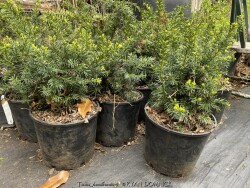

***Shrub descriptions available with future update!***Capitata Upright Pyramidal Yew, is also known as Taxus cuspidata 'Capitata'
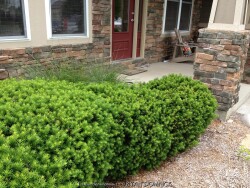

Densiformis Hedge Yew (Taxus x media 'Densiformis') is an evergreen shrub with small flat needle-like dark green leaves. Small red "fruits" form on mature plants with proper pollination and in the absence of pruning. This yew is of hybrid origin along with many varieties ranging from small shrubs to small trees. Taxus x media varieties grow rather slowly and lend themself excellently to being pruned into hedges as long as not too much is taken off at one time. After a plant achieves a certain height, you may keep it that size indefinitely with 3 to 4 times per year pruning. Yews prefer part shade with rich to average well-drained soil and average moisture. Yews planted in the full sun will survive but develop an burnt yellowish green color when temperatures exceed 100°F. This is usually a problem in zone 6 or further south as there are many better choices for full sun (morning sun is okay). In zones 4-5, full sun is probably okay. Yews are best known for their tolerance to dry shade even under root bound conditions. They will not survive more than a couple years under a roof overhang due to lack of moisture in the winter and spider mite problems. In the Eastern and Southeastern United States, Yews have many problems including root rot, insect and disease issues. None of these are a problem in Kansas or Oklahoma with lower rainfall amounts and less humidity. In the landscape, yews offer a year-round structure. They definitely help provide a background for more interesting plants with colorful foliage and flowers. They are also very well known and used in formal garden designs. We prefer to see them less pruned and then there more natural state. A word of caution is that yews are poisonous.
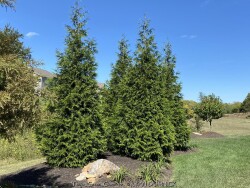

***Tree descriptions available with future update!***
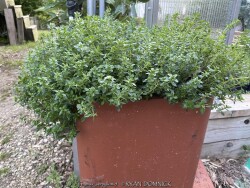

***Description for this perennial available with future update!***Mother of Thyme, is also known as Thymus serpyllum